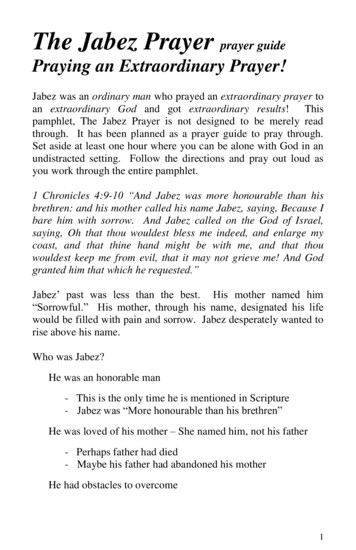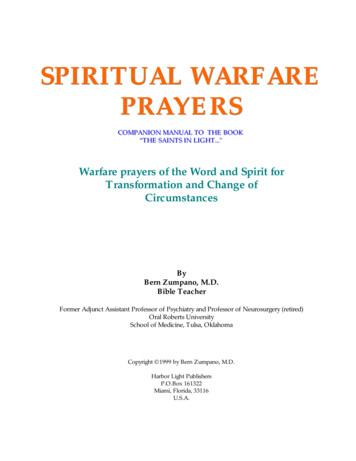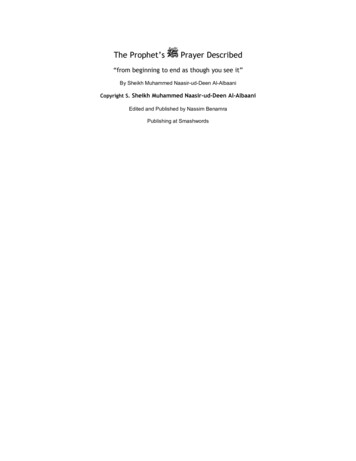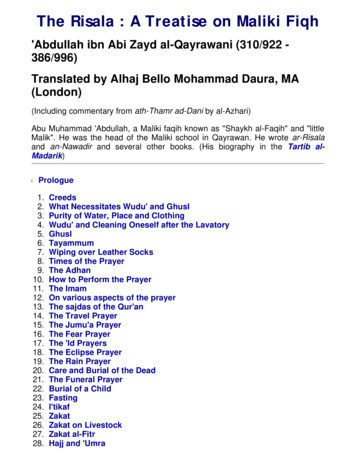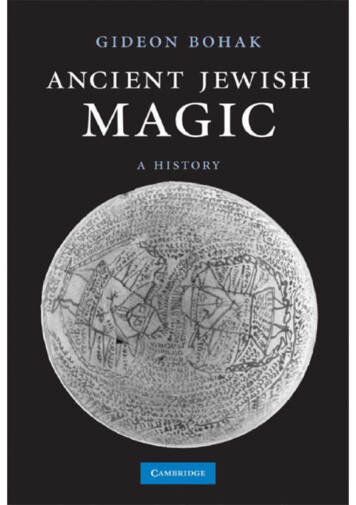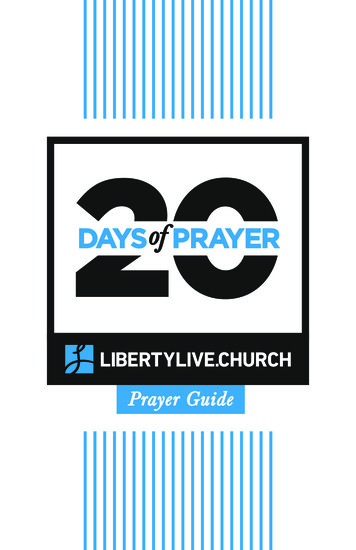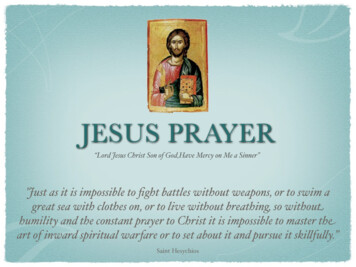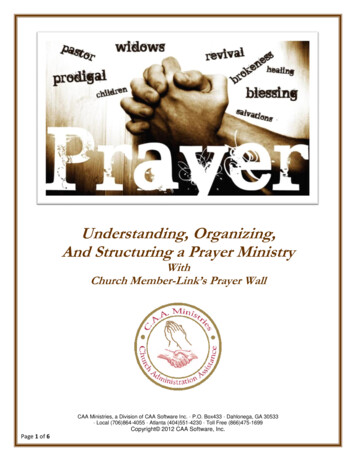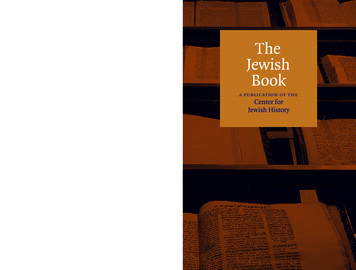
Transcription
CONSERVATIVEJUDAISMVO L. IIO C T O B E R , 1945 ־ H EiSH V A N , 5706Nto. 1A Jewish Prayer Bookfor the Modern Age*By R O B E R T G O R D ISWH E N Solomon Schechter declared, “at a time when all Jews prayed, oneprayer book sufficed their needs. Now when far less Jews pray, more andmore prayer books are required,” he was delivering himself not of an epigrambut of an acute historical observation. The prayer book became a problem forJews when Judaism as a whole became a problem. Hence the issues involved canbe understood only in terms of this larger framework of Jewish life.P rior to the Emancipation, the nushaot or variants in traditional prayerbooks were principally matters of local “minhag” ; even the Hasidic controversyintroduced variations without significant differences. The spiritual climate ofthe prayer book in all its forms was basically the same, exactly as the social,economic and cultural character of the scattered Jewish communities varied onlyin the slightest degree.W hen the Jews of W estern Europe were granted civic and political equality,however hesitatingly, and new economic opportunities opened before them, afar-reaching spiritual revolution was set in motion. As they entered W esternculture, they began to desert traditional Jewish life. One of the first consequenceswas that the prayer book, the classic expression of traditional Judaism, becameincreasingly unpalatable even to those Jew’s who retained a sense of attachmentto the Jewish group. There were, of course, thousands of Jews who regardedthemselves as enlightened and advanced, for whom Jewish values and practicescould not be made relevant under any circumstances, for whom the game was* This paper was presented at the forty-fifth Annual Convention of the Rabbinical Assemblyof America on June 27, 1945.Conservative Judaism, Vol. 2 No. 1 Copyright 1945 by the Rabbinical Assembly
Conservative Judaism2not worth the candle. Through conversion and intermarriage they and their de scendants cut the links that bound them to Judaism. Only subsequent develop ments made it all too tragically clear that they had not succeeded in divorcingtheir destiny from their Jewish origins.Many other Western Jews, however, found it impossible to dissociate them selves completely from their Jewish heritage, for a variety of reasons. In someinstances, this reluctance had no theoretic basis, but stemmed from a deeply humandesire not to hurt pious parents and grandparents. In others it was a sense ofnoblesse oblige} a conviction that self-respect forbade deserting the sinking shipof Judaism merely out of a desire to further one’s own interests. For manymore it was a genuine love for Jewish life, however unconscious and even shame faced, in a world that doted upon novel intellectual fashions every day. Finally,for many Jews it was the lash of antisemitism which reminded them of theirJewish background. For all these groups, Judaism remained part of their heri tage, but none of them were prepared to surrender their hard-won place inWestern society or the enlarged vistas of modern culture. For them the prob lem of adjusting their Judaism to modern life arose.“Adjustment” is a sonorous term that effectively disguises a process not al together happy. All too often it resembles the Procrustean bed of Greek myth ology or the mitat sedom of Jewish legend. For the hospitable Sodomite, it willbe remembered, fitted every wayfarer to the bed he had prepared by lopping offhis limbs if they protruded or stretching him on the rack if his frame was tooshort. Generally the modern adjustment to Judaism followed this procedure—an amputation of the rich and variegated character of Jewish life or the stretch ing of one phase of Judaism out of all proportion to its place in the organicwhole. By and large, adjustment meant reduction both in intensity as well as inextent, so that Judaism was reduced to the modest dimensions of a decorousnear-Protestant cult.Similar criticisms of the Reform movement have been made before. How ever it has usually been overlooked that these strictures notwithstanding, Re form was an expression of the Jewish will to survive and that its protagonists,however mistaken, were actuated by a genuine desire to preserve their heritage.Those who lacked that impulse found quicker and easier ways to escape theirJewish background. When this is recognized, it follows naturally that Reformhas positive achievements of no mean order to its credit. Within its ranks, whichoriginally included moderate as well as extreme views, were men like AbrahamGeiger whose brilliant re-interpretations of Jewish values and emphasis ondevelopment in Judaism are still significant; Leopold Zunz, the father of thescience of Judaism who favored necessary modifications,(1) and Leopold Low,whose contributions to the problem of change in Jewish law are still valuabletoday. Even the patent errors and inadequacies of Reform Judaism have highpedagogic value. If we today strive to avoid them, it is in large measure becauseO)For Zunz’s views on the Hamburg Prayer book cf. Elbogen, I. D er jüdische Gottesdienstin seiner geschlichtlichen Entw icklung, L eipzig, 1913, p. 415.
3A Jewish Prayer Bookof the previous experience of “classical” Reform Judaism, which serves both asan example and a warning. Obviously, for us to repeat them would be the heightof folly, but only because others have paid the price of experience.Moreover, the contribution of Reform, used in the broadest sense, is by nomeans purely negative. Much of its achievement is today common propertyfor all the modern schools in Judaism, Orthodoxy and Conservatism as well asReform. It seems to us undeniable that Reform fulfilled a function which neededto be done. The emphasis upon decorum in worship, the elimination of manysuperstitious accretions in observance, the introduction of the sermon in the ver nacular, the elimination of such abuses as the selling of honors in the synagogue,the reduction of the piyyut, the sanctity of which derived in large measure fromits incomprehensibility, were each of them bitterly opposed as representing anaffront to tradition. This in spite of the fact that for centuries leading rabbinicauthorities had attacked some of these abuses to no avail. Even the productionof properly printed prayer books, free from scribal errors and grammatical mon strosities, was an achievement of the modern trend in Judaism. These and similarchanges do not seem radical today, appearing rather as part of the naturaladjustment of Judaism to the modern age.Other changes were not so easily or universally accepted. The introductionof choral singing by females or mixed voices aroused widespread objectionsamong traditionally minded elements. The organ in particular became the symbolof both moderate and extreme Reform in Europe. On the other hand, familypews and bare-headed worship made practically no headway on the Continent.As a result, these characteristic practices of American Conservatism and Reformrespectively remained virtually unknown in Germany, France, Italy and England.IIIt is against this background that the efforts to modernize the traditionalprayer book must be viewed. The motives that impelled a revision of the liturgywere both conscious and unconscious—that is to say, some were reasons andothers were rationalizations. Among the conscious factors was a desire to reducethe length of the service by curtailing less important elements like the PesukedeZimrah and the Piyyutim. Closely related was the wish to make the servicemore intelligible by supplementing the Hebrew prayers or replacing them byprayers in the vernacular. Time revealed that this trend, like many other tenden cies in Reform, had a dangerous spiral tendency. Otice set into motion, the trendcontinued to gain momentum, so that beginning with comparatively minor inroadsof the vernacular, it finally drove Hebrew almost completely out of the service.It was a prophetic recognition of this peril that led Frankel to withdraw fromthe Brunswick Rabbinical Conference of 1844, when the assembly voted to retainHebrew only out of deference to the sentiments of the older generation.
Conservative Judaism4While prayers in the vernacular were urged on the grounds that they addedgreater meaningfulness to the service, in practice they created a new and un expected complication. Hebrew prayers chanted in the traditional manner couldbe repeated at almost every occasion without producing a sense of monotony inthe worshipper. In the first instance, the traditional congregant was an activeparticipant in the ritual instead of being a member of a silent audience. Themass chanting and swaying might not be very decorous by Western standards.It had the virtue, however, of being alive. The old psychological principle of“no impression without expression” embodied in Jewish prayer made the experi ence emotionally vibrant and satisfying. Second, the characteristic musical modesand Scriptural cantillations, which differ with the varying occasions of the year,served to create a distinct mood appropriate to the day and added variety andinterest, even when the text remained the same.All these unconsciously acquired resources were swept into the discard byReform. The penalty was swift. As the different traditional modes and Scripturalcantillations were abandoned or circumscribed and were replaced by responsiveand unison readings in the vernacular, the monotony of the service becamemarked.(2) This new problem was now met by the device of varying the text ofthe prayers. Thus Samuel Holdheim’s German Reform Prayerbook of 1856 con tained nine cycles, the American Union Prayer Book contains five services for theSabbaths of the month (obviously not the Jewish month!), as well as five addi tional services for special Sabbaths. The English Reform Prayer Book preparedby Rabbi Israel Mattuck of London has no less than thirty distinct services.Nevertheless, the frequently voiced complaint that the Reform service is cold anduninspiring and the congregation inert and unresponsive gives grounds for doubt ing that the problem has been adequately met.The objections noted above dealt with the language, the form and the lengthof the service, problems in which the laity were interested, at least during theperiod of transition. On the other hand, modifications were also urged in thecontents of the prayer book on dogmatic grounds. As Elbogen has acutely noted,these changes were of moment to theologically trained rabbis, but did not concernthe laity much. Such features of the traditional liturgy as the resurrection, thepersonal Messiah, the re-establishment of the Davidic dynasty, the re-introductionof animal sacrifices, the restoration of the Jewish people to Palestine, the conceptof the Chosen People, and the distinction between Israel and the nations, wereopposed on the ground that they were not in harmony with the advanced religiousideas of the modern age. Elbogen, himself a leader of moderate German Reform,made a devastating comment on the motives behind much of this agitation whenhe noted that it was motivated by political considerations. He points out thatWestern Jews did not hesitate to trim their religious ideals and were quite willingto sever the link binding their destiny to their brothers elsewhere in the world, inorder to render unassailable, as they thought, their political rights and economic(2)Ibid, p. 425.
A Jewish Prayer Book5opportunities as c i t i z e n s . T h a t identical tendencies have appeared in contem porary American ־ Jewish life is evidence of the truth of Koheleth’s words, “Thereis nothing new under the sun,” or, to cite a more recent philosopher, GeorgeSantayana, “He who does not know the past is doomed to repeat it.”In the name of universalism, Reform leaders raised a hue and cry againstJewish “particularism,” quite unaware of the fact that the dichotomy betweenthese two polar forces has no objective reality in Hebrew thought. Actually, itis an invention of German theologians and their disciples, who sought a methodfor preserving the Bible, while condemning the people that had created it. Nowthis passionate advocacy of universalism and excoriation of nationalism by Re form spokesmen was strictly limited to the Jewish scene. Nowhere did theaccredited leaders of “modern” Judaism cry out against the aggressive and mili taristic nationalism of Germany, France, England and Italy which plunged nine teenth century Europe into war after war and brought civilization to the brink ofextinction twice in the twentieth. On the contrary, it is hard to find anywhere morefervent preachers of patriotism and boundless loyalty to the state than amongthose Jewish apostles of “universalism.”There is another proof that practical considerations rather than philosophicalideals were at the roots of the objections to the traditional liturgy. It lies in theprocedure adopted by Reform with regard to the passages dealing with the reintroduction of sacrifices and the restoration to Zion. Elsewhere prayer bookeditors had had no difficulty in excising or modifying the traditional text, pre serving what they thought worthwhile and eliminating the rest. But it did notoccur to them to make a distinction between these two ideas, which are oftenlinked in the traditional prayer book, to be sure, but are by no means inseparable.Reiterating that no modern person could pray for the restoration of sacrifices,they proceeded to eliminate with these prayers all petitions for the restorationof the Jewish homeland. The conclusion is inescapable that the objection tosacrifices served as a cloak for eliminating the hope of a reestablishment of Israelin its ancestral home.It is noteworthy that only in two instances was it recognized that these twoideas were not necessarily interdependent, both times within Conservative ranks/4)Zechariah Frankel stated that he favored the elimination of the petition for therestoration of sacrifices but not the deletion of the Messianic hope. Unfor (3)Ibid, p. 422f: “Es war eine Fortsetzung dieses Irrtums, wenn die Gemeinde von denpolitischen Verhältnissen Deutschlands ihren Ausgang nahm, sich auf die deutschenGlaubensgenossen beschränken wollte; der Gegensatz von religiöser und vaterländischerGesinnung hatte keine innere Berechtigung, eine wirklich religiöse Reform musste füralle Juden anwendbar sein. Und endlich war es eine Verkennung der Wirklichkeit, wenndie Gemeinde die Erfüllung des messianischen Berufes des Judentums für sich alleinin Anspruch nahm; dieses Streben verfolgte die gesamte Judenheit, freilich auf demBoden des geschichtlichen Judentums, nicht auf dem des freien Menschentums, wie dieWortführer der Genossenschaft verkündeten.”Cf. also pp. 390 and 405 where he wisely notes that political prejudices must be fought onpolitical grounds, and that the belief in the Messiah was no real basis for denying polit ical equality to Jews, as Macaulay had noted. 4 Cf. JE, art. “Prayerbook,” vol. 10, p. 178b; Elbogen, op. cit. p. 432.
.6Conservative Judaismtunately, here, as in so many other respects, Frankel contented himself with negative criticism rather than with positive action. In England, the West-LondonSynagogue whose minister was Morris Joseph, the author of “Judaism as Lifeand Creed,” actually proceeded to delete the passages dealing with sacrifices butretained the prayers for the restoration to Zion.To revert to the main theme, all these objections to the language, length, formand content of the traditional liturgy were so far-reaching that they necessitated aradical transformation of the Siddur and the Mahzor. In Germany, Reform wasunable or unwilling to break so violently with tradition, and so it produced aprayer book which made some adjustments along these lines, but later reintroducedmany traditional features/5* In America, where there was little Jewish learningamong the laity and no deeply rooted tradition of practice, Reform was ableto follow its logic to its consequences or go to extremes—the phrase used dependson the point of view! The natural consequence was the creation of the UnionPrayer Book which bears only a slight resemblance to the traditional liturgy.As a result, the Prayer Book became one of the most important dividinglines between the traditional and the anti-traditional elements. Since Reform hadmade a modification of the prayer book one of its cardinal planks, the adherentsof traditional Judaism made the retention of the original a matter of principle.Frequently recourse was had to the rabbinic (Tos. Ber. 4 ;5 ed. Zuckermandl, p. 9) “ כל המשגה ממטבע שטבעו חכמים בברכות לא יצא R. Jose said, *Whoever deviates fromthe form established by the Sages for the blessings has not fulfilled his religiousduty/ ” It was generally overlooked that this statement refers only to the ברכות הנהנין , as is clear from the text itself, as well as from the context inwhich it is cited in the Talmud (Babli, Berahot, 40b; Yerushalmi, Berahot vi, 2 ).(6 The very genuine problems of a Jewish prayer book in the modern age wereignored merely because the solution of Reform was found inadequate.As in so many other aspects of Judaism, there was a need of a synthesis ofthe old and the new, the traditional and the contemporary. That the difficultiesare tremendous, even without the problem of adjustment, is graphically indicatedby two very sound judgments on the art of translation expressed in the TalmudOne declares: ( אין מקרא יוצא מידי פשוטו Shab. 63a and often). “The literalmeaning of a text cannot be disregarded,” and the other המתרגם פסוק כצורתו ( הרי זה בדאי Kid 49a), “Whoever translates a text literally falsifies it.” Yet, complex as is the task of making traditional Judaism vital and creative in the modernworld, we cannot desist from it—for nothing less is the historical mission of ourmovement.(5)Cf. theLevin revision of the Berlin prayerbook 1885 and the Prayerbook edited byI. Elbogeni(6)In the Vilna Jerushalmi, the citation reads: כל המשנה על המטבע שטבעו חכמים לא יצא (Li UVCUl The omission of בברכות does not affect the meaning. The passage is citedin connection with the Mishnah dealing with the blessings over fruits and vegetables.Rabbi Solomon Serillio, ad 10c. specifically notes this limitation in his commentary onthis passage in the Jerushalmi: שטבעו חכמים בברכות — בברכות ההנייה דאי בתפלה האמיר בפרק קמא דע"ז דאם בא לו מד בתפלתו מעין כל ברכה וברכה כסדר יום הכפורים יצא
7A Jewish Prayer BookIIIThe slow gestation of Conservative Judaism and the lack of clarity in itsoutlook during its early stages is reflected in its approach to the Prayer Book.Historically, it was the “left-wing” of modern traditional Judaism which firstemerged on the American scene. The close relationship of this group to Reformis to be seen in its procedure with the Prayer Book. Two of its great leaders,Marcus Jastrow and Benjamin Szold, produced the “Jastrow Prayer-Book” whichis still used in some of our congregations. These great scholars and lovers oftraditional Judaism, one of whom, at least, was a pioneer of the Zionist ideal inAmerica, produced a prayer book that can only be described as mildly Reform.The reason is surely to be sought in the conditions of the time. These pioneerssaw the rising tide of extreme Reform which seemed to sweep everything beforeit. They doubtless believed that only some kind of modified Reform had thefaintest chance of success in America.This consideration would seem to explain why their work is more radicalin many respects than “Minhag Amerika,”(7) the prayer book of Isaac M. Wise,the builder of Reform Judaism in America. Wise’s strength lay far more in hiszeal for unity and organizational skill than in his philosophic depth and consistency.In fact, his desire for unity in American Israel had led him to subscribe tothe statement of principles adopted at Cleveland in 1855, in which the Talmudiclegislation was accepted as binding!At all events, the Jastrow Prayer Book eliminates all references to a restoration to Zion and reduces the Pesuke DeZimrah very drastically. It does nothesitate to paraphrase the Hebrew original in a manner which bears only theslightest relationship to the traditional text, a procedure Geiger had adopted in1854 in his prayer book. Its traditional character resides largely in its retentionof the Hebrew language and the basic structure of the service, as against theReform prayer books, which were rapidly reducing the use of the sacred tongueto the vanishing point.Another Conservative prayer book of the “left-wing” was produced by B. A.Elzas. Elzas, himself a Reform rabbi, based his work on the Union Prayer Book,the Olat Tamid of Einhorn and the Jastrow Prayer Book, which had all precededhim. Like most pioneering works, his ritual abounds in inconsistencies. Thusthe phrase, mikol hafamin is eliminated in the Hebrew of the Kiddush, but,strangely enough, is included in the parallel English version as well as in theblessings over the Torah. Elzas was, however, a Biblical scholar of considerableoriginality. His first-hand knowledge led him to many felicities in translation.(7)(3)Thus W ise retains the traditional text in a) מתי תמלוך ציון in the Kedushah, whereSzold reads מתי תמלוך על כל העולם b) in ובא לציון גואל which Szold deletes, c) in ו ת חזינ ה where Szold reads בא" י שאותך לבדך ביראה נעבוד d) in ומביוא גואל where Szoldreads ומביא גאולה e) in צור ישראל where Szold omits: ופדה כנאמך יהודה וישראל On the prayer-book see the valuable studies of Rabbi Moshe Davis, notably his Hebrewpaper “Benjamin Szold and Marcus Jastrow” in the S e je r Hashanah L iyehude A m erika,5702 (1942) pp. 427-39, and the comparative tables which appear only in the off-printsof this paper. Rabbi Davis’ forthcoming volume “The Development of Historical Judaismin America” will be a significant contribution to American-Jewish religious history.
8Conservative JudaismHe recognized that the word “shem” in Biblical Hebrew often means “essence”and therefore need not be translated into E!nglish.(9) In fact, a literal renderingonly leads to complications. Thus, Elzas correctly translates ברוך שם כבוד מלכותו לעולם ועד . as “Blessed is His glorious kingdom forever and ever,” and הטוב שמך ולך נאה להודות as “the All-good, to whom alone all praises are due.”In appearance and spirit these “left-wing” Conservative prayer books showa marked affinity with Reform from which they stem. Similarly “right-wing”Conservative congregations, which derived from Orthodoxy, retained the traditional prayer book unchanged, except for omissions of some technical passageslike במה מדליקין and פטום הקטרת . Thus far, the contributions of our movementto the Jewish liturgy have lain principally in better printed editions, more attractive English versions and the use of supplementary material.The “Friday Evening Service” by Rabbis Israel H. Levinthal and IsraelGoldfarb have been widely used and deservedly popular. Rabbi Jacob Bosniansconvenient editions of the daily, Sabbath and Festival service have also 'found alarge public. Rabbi Solomon Goldman has issued “Prayers and Meditations” inwhich the traditional text is enriched by a large number of responsive readingsand other prayers drawn from all branches of Hebrew literature as well as by avery elaborate hymnal prepared by Harry Coopersmith. Rabbi Morris Silverman’sSabbath and Junior Prayer Books as well as his excellent High Holy Day PrayerBook, which had the benefit of the counsel and aid of many of his colleagues, havebeen adopted by many congregations.In addition, several of our colleagues have produced liturgies for special occasions. Rabbi Louis Feinberg’s edition of the ((Selihot for the First Night” isbeautifully poetic and infinitely superior to the editions generally current. TheRecons'tructionist group has issued the very attractive “New ׳ Haggadah” containing many changes, omissions and additions. The traditional Haggadah translated by Maurice Samuel is enriched by a superb introduction by Rabbi LouisFinkelstein.More recently, Rabbi Sidney Guthman in collaboration with Cantor RobertSegal, has published a Friday Evening Service in which the material of thetraditional liturgy is divided into several distinct services. The ReconstructionistPrayer Book which has appeared within the past few months is a tribute to thecreative originality of its authors, in spite of its patent weaknesses.These works, though often drawing upon the collective experience of ourcolleagues, were issued on individual responsibility. The only collective enterprise in the field has been the United Synagogue Mahzor for the PilgrimageFestivals, which is, without question, the most attractive traditional prayer bookyet issued. The volume is distinguished by a sharp reduction in the extent of thepiyyut, the addition of several supplementary prayers, many felicities in transíation and a beautiful setting of the Hebrew prayers, particularly the Psalms, in amanner calculated to reveal the poetic beauty of the original.(9)Thus Ps. 124:8 ' עזרנו בשם ה and Ps. 121:2 ' עזרנו מעם ה are identical in meaning.
9A Jewish Prayer BookIVThis method of approach would have sufficed, if the traditional prayer bookas it stands, without change or interpretation, were adequate from our point ofview. As our movement has grown and developed, however, most of us havebeen led to recognize that, unsatisfactory as the Reform modifications of theprayer book are, the traditional Siddur and Mahzor need to be reconsideredfrom the standpoint of both principles and techniques.This goal might have long remained unrealized were it not for the fortunatecircumstance that Rabbi Morris Silverman of Hartford, Connecticut, who hadbeen working in the field for many years, had prepared a manuscript for a Sab bath and Festival Prayer Book containing a new English translation, much sup plementary material and original prayers. In his work he had drawn upon thecounsel and aid of many of his colleagues and of several distinguished scholars,notably Professors Louis Ginzberg and H. L. Ginsberg of the Jewish TheologicalSeminary of America, who are naturally not responsible for its final form.In the Fall of 1944, the Rabbinical Assembly and the United Synagogueagreed to adopt Rabbi Silverman’s manuscript as the basis for a prayer book tobe issued jointly by them. A Commission was created by the two bodies withcomplete authority to revise, supplement, and edit the material. This Joint PrayerBook Commission consisted of the following rabbis: Robert Gordis, Chairman;Morris Silverman, Editor; Max Arzt, Secretary; Simon Greenberg, Jacob Kohn,Israel H. Levinthal, Louis M. Levitsky, Abraham A. Neuman, Elias L. Solomon.This Sabbath and Festival Prayer Book is being issued on the collective respon sibility of the Joint Prayer Book Commission.The procedure adopted by the Commission was as follows: The membersof the Commission met at frequent intervals, for the study of the Hebrew textand the English version in the light of previous efforts in the field, the best avail able scholarship and our own approach to Jewish tradition. Individual membersundertook research on special points and the preparation of supplementary notes.In addition, a sub-committee met between plenary sessions of the Commissionfor intensive consideration of special problems.In the course of the concentrated, day-by-day labors of the Prayer BookCommission, certain fundamental principles evolved. It is for others to judgeof the degree of success the Commission has achieved. But these principles, Ibelieve, are significant for our approach to the problem of the Jewish liturgy, aswell as for the philosophy of Conservative Judaism* as a whole. They must, itseems to us, constitute the basis of a Jewish prayer book in the modern age. It is,therefore, of more than academic interest to set forth these guiding principles:A. C O N T IN U IT Y W IT H T R A D IT IO N . Important as tradition is forevery faith and culture, it is infinitely more significant for Judaism and theJewish people. This is true, not only because, as Ranke declared, Jews are
10Conservative Judaismthe most historical of peoples, but also because of the limitless centrifugalforces that threaten Jewish survival, and against which loyalty to tradition is thestrongest bulwark. This continuity has “horizontal” as well as “vertical” aspects,that is to say, there must be a strong sense of association, not only with thegenerations gone before, but with our brothers the world over, whom Schechtercalled “Catholic Israel.” Nbr is it merely a matter of the retention of the wordsthat is involved. Generally, the spirit of the Jewish service inheres far more inthe Hebrew language, in the traditional melodies, and in the well-known andwell-loved customs—one is almost tempted to say—in the easy familiarity thatour ancestors displayed in the house of God, which, unfortunately, degenerates soeasily into mere lack of decorum among their descendants!This emphasis upon continuity is not mere ancestor-worship on our part.As Israel Zangwill declared, ours is not a religious generation. Whatever othervirtues we may possess, we lack that genius for religious expression which is sobeautifully exemplified in the traditional prayer book. This consideration cannotfree us from the obligation to strive perpetually after fresh and creative devo tional forms. But it should prevent us from rashly laying hands on the productof the piety of earlier generations.A striking illustration of the superiority of traditional religious thought overour modern conceptions lies in the awareness of evil. Modern prayer books ofall types tend to minimize and soft-pedal the existence of evil in the world. Sin,wickedness and evil-doers have all but disappeared from their pages. In thisrespect they reflect the melioristic, comfortable philosophy of the nineteenth cen tury, which looked forward to a painless and automatic progress guaranteed
of properly printed prayer books, free from scribal errors and grammatical mon strosities, was an achievement of the modern trend in Judaism. These and similar changes do not seem radical today, appearing rather as part of the natural adjustment of Judaism to the modern age.
